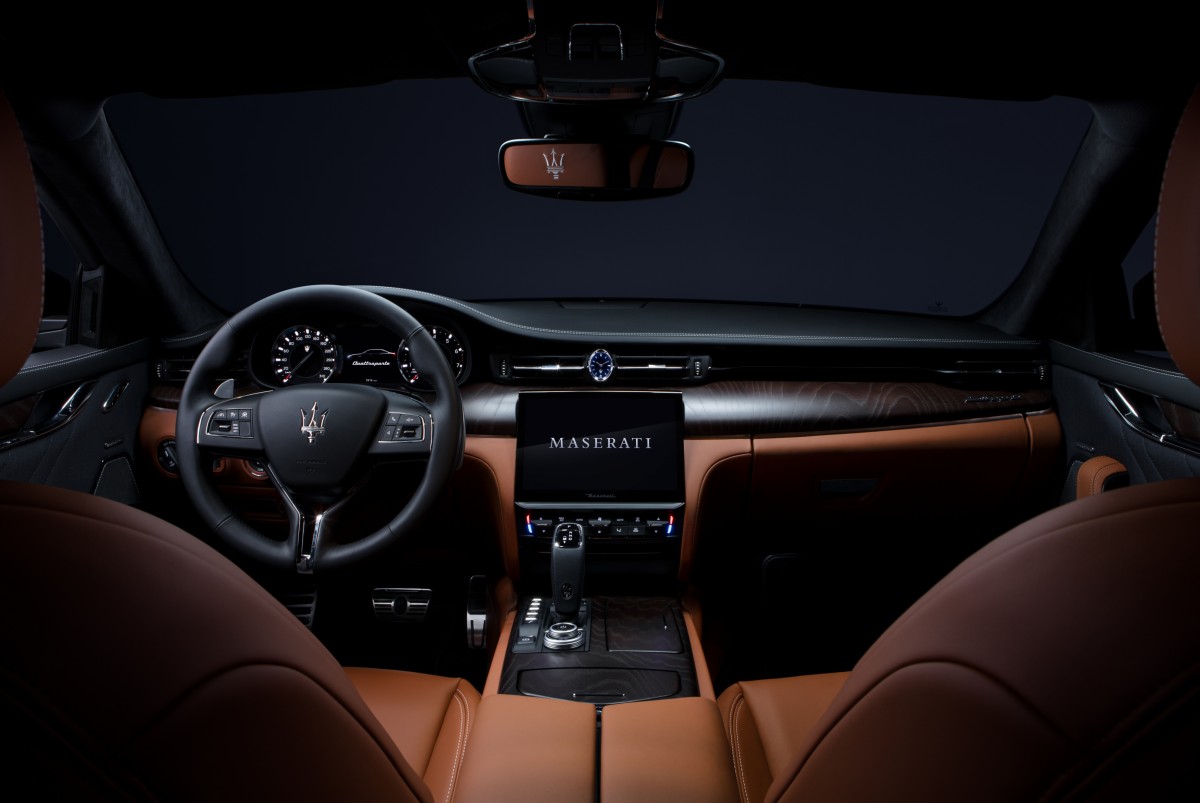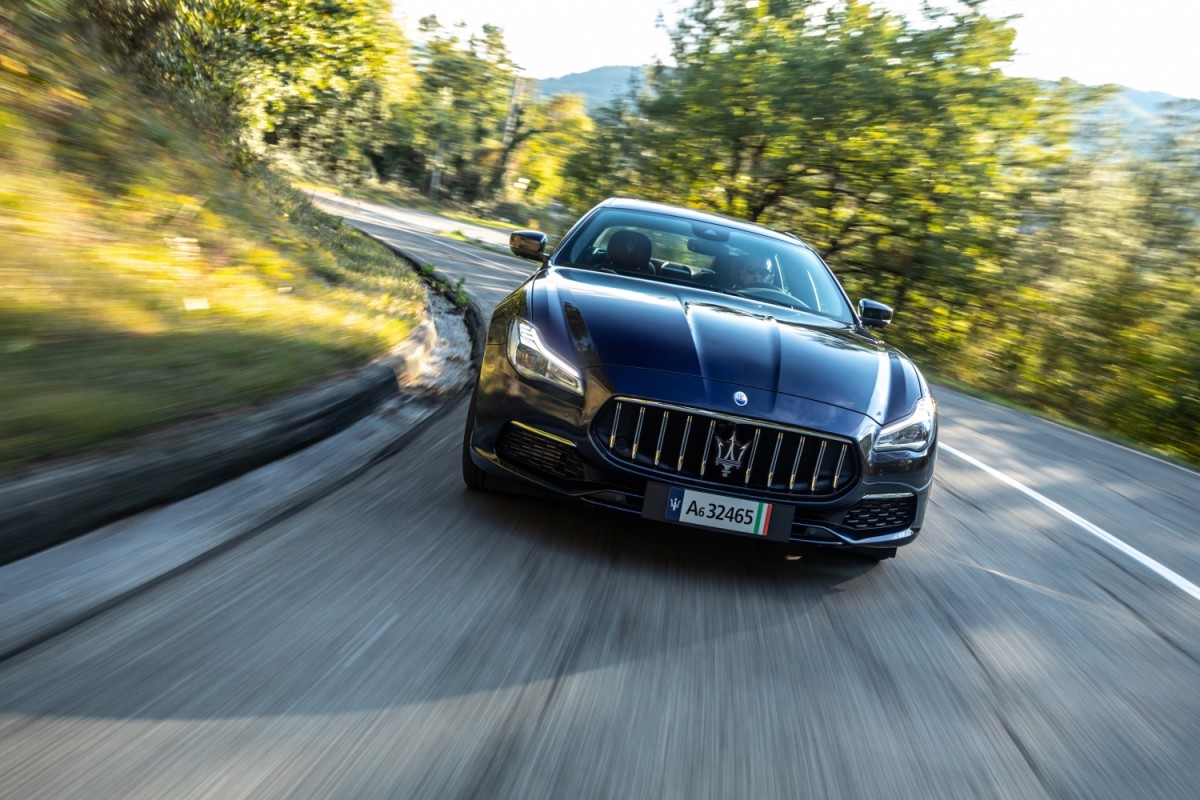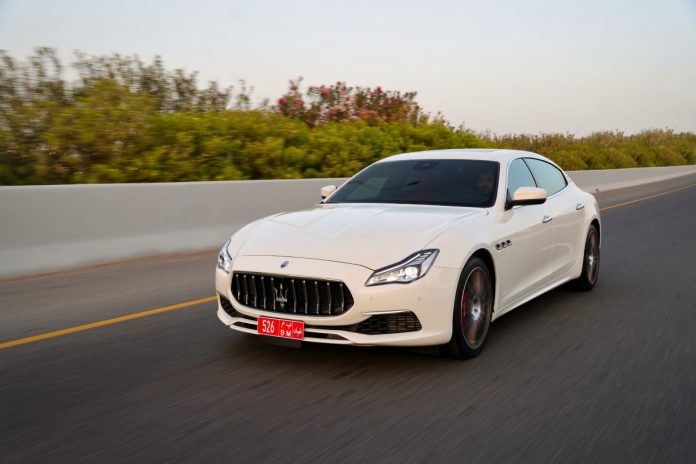The Maserati Quattroporte is a classic example of authentic Italian design, the Quattroporte has embraced gracefully the virtues of elegance and athletic attitude, particularly in the GranLusso and GranSport trims.
The best Italian designers have been involved in developing the design language of the Quattroporte throughout its 55-year history. In 1963, the first Quattroporte seamlessly fused the qualities of speed, style and luxury in a sleek body designed by Pietro Frua – and ever since, Maserati has been considered a master of sports sedan design.
The second-generation version in 1974 was designed by Bertone but it was Giorgetto Giugiaro’s 1979 Quattroporte that saw great success. Marcello Gandini redefined the flagship sedan with his compact 1994 Quattroporte, while Pininfarina’s 2003 model set the segment’s design standard for almost a decade.
The modern-day Quattroporte is as distinctive and exclusive as its predecessors the least. The dominant, powerful nose is sculpted around the Alfieri-shaped three-dimensional grille, which is pointed and imposing, featuring vertical chrome rib elements that contrast with the depth of the ‘sharknose’ effect.
Beneath the rear bumper, the GTS version can be identified by its twin, trapezoidal, integrated dual pipe exhaust system in chrome-plated stainless steel.
Aerodynamic Drag coefficient 0.28
A large part of the Quattroporte’s aerodynamic work takes place out of sight beneath the car. The flat floor comprises several aerodynamic features, including a NACA duct to help cool the differential without increasing drag, and flaps on the rear suspension arms to channel airflows.
The signature Maserati grille is a functional element of the car’s active aerodynamics, integrating an Air Shutter between the air vents and the radiator. The electrically-adjustable device provides optimal control of the engine temperature, reduces the aerodynamic drag and subsequently improves fuel economy and CO2 emissions. As a result, the Cx coefficient of the Quattroporte is an exceptional 0.28.
There is a choice of ten body colours in the MY19 Quattroporte range. Two of them are brand new tri-coat colours, the race-inspired Rosso Potente, which has been created to celebrate the heritage of Italian sports cars, and the Blu Nobile, with sparkling glass flakes glimmering under the sunlight. There is also a choice of nine alloy wheels in six different designs in sizes ranging from 19 to 21-inch. Brand new for MY19 are the 20-inch Perseo and the 21-inch Atlante wheels, both available in light and dark finishes.
The V6 versions are standard equipped with 19-inch wheels fitted with 245/45 R19 front and 275/40 R19 rear tyres. The top-of-the line Quattroporte GTS features standard 21-inch wheels with 245/35 R21 front and 285/30 R21 rear tyres.
Adaptive full LED headlights
The Adaptive full LED headlights are fitted as standard on all Quattroporte versions for low and high beam, Daytime Running Lights (DRL), parking and turn lights, featuring Static Bending Lights and automatic height regulation. The full LED headlamps feature horizontal DRLs and a three-blade design inspired by the signature Maserati wing air ducts.
The LED headlights include a front camera that supports ‘BiLed Glarefree’* adaptive high beam. This function can create a light ‘tunnel’ by lowering the beams to reduce the light shining on vehicles travelling towards you, while keeping all other zones fully illuminated. This allows the driver to maintain high beam without dazzling oncoming drivers.
The headlights can also interact with different vehicle parameters to activate one of the following lighting scenarios: Town (< 50km/h), Country (50-110km/h), Motorway (>110km/h) and Weather modes.
GranLusso, GranSport and updated Nerissimo package
The GranLusso and GranSport trim levels are available as an upgrade for all V6 versions, representing the perfect blend of luxury and performance. The top-of-the range Quattroporte GTS is available exclusively with either of these two trims.
The GranLusso trim is distinguishable by its front lower fascia design, featuring an elegant floating bridge element and a subtle spoiler. It is rounded off with a chrome bumper finish and body-colour bumper profiles.
Interior Excellence:

Pieno Fiore natural leather and new veneers are available in the sumptuous interior of the Quattroporte, which also features improved infotainment graphics and climate control ergonomics.
Thanks to its long wheelbase, the latest-generation Quattroporte has set a benchmark for roominess, while its stylishly neat interior gives both driver and passengers the sensation of travelling in an exclusive first-class lounge.
The interior delivers streamlined, wraparound forms, which endow the dashboard and tunnel with a feeling of lightness. The dashboard features a full-width surface in a variety of exclusive, precious trims, underlining the refined character of the Quattroporte and rounded out by decorative inserts on the front and rear door panels.
The interior is focused around a driver-friendly interface. The instrument cluster’s large, analogue rev-counter and speedometer flank a 7” TFT display for many of the car’s operational features. The leather-finished steering wheel is electrically adjustable for both reach and height.
The MTC+ infotainment system is based on a high-resolution 8.4” capacitive touch screen, which features updated graphics and improved Climate Control functions for MY19. A double rotary knob in forged aluminium provides intuitive control of the audio volume and other functions.
For MY19 the center console accommodates a redesigned gearshift lever and a revised button cluster for the driving modes and is also available now with two American size cup holders* – a standard feature in the cars intended for the US and Canada markets.
The roomy, comfortable three-seat bench offers excellent legroom in the rear. Two individual seats are also available as an exclusive option on the Quattroporte GranLusso. They feature ventilation and electrical movement, ensuring unbeatable relaxation during long working trips, and they can also be fitted with individual entertainment screens.
The rear armrest has a USB socket for charging mobile devices and two foldaway cup holders. An ashtray on the door panel is now available as an option. The rear seats are equipped with ISOFIX fittings.
The interior lighting uses an optical fibre running along the dashboard and doors, including the door handle cavities and door pockets, to give the interior a modern, classy look. The ergonomically designed dome console includes the boot lid button and a parking sensor control switch on the right of the sunroof controls, in the dome lamp area.
The front and rear ceiling lights incorporate a diffused lighting lamp and two separate reading lights. Two LED lights concealed in the ceiling light softly illuminate the area beneath them, while the foot area is also illuminated.
The Quattroporte interior also features a box for phone storage, three 12V power sockets and a USB charging port in the rear armrest. A number of large compartments are available, two of which are at the bottom of the dashboard: a climate-controlled, illuminated passenger glove compartment and another for the driver, as well as an illuminated, climate-controlled storage area beneath the large front armrest. A Valet Mode* is available in the touchscreen menu that electrically locks the passenger glove box. While this mode is active, the glove box is only accessible by inserting a four-digit PIN number.
The rear seats are 60-40 split and partly (40%) folding, allowing long objects to be stored in the 530-litre luggage compartment.
Climate control with Air Sensor
Quattroporte is equipped with an Air Quality Sensor that substantially improves the comfort of occupants on-board. The system combines an intelligent sensor and a signal analysis system that calculates external pollution levels and prevents polluted air and toxic gases from entering the cabin.
The standard dual-zone climate control delivers great amounts of air through 13 ventilation ports, with four of them in the rear of the car. It balances its output through a sunlight sensor, providing seamless maintenance of the selected temperature. An electronically-controlled, variable-displacement compressor ensures efficient climate control. A wide array of sensors – including a humidity and a sunlight sensor – provides the system with the necessary information.
The four zone automatic climate control improves comfort for the rear passengers including a separate temperature control unit in the rear seat, a dedicated nebuliser and two additional ports on the B-pillars to increase airflow to the rear seats.
Keyless Entry, Soft Close Doors and Power Boot Lid
Incorporating Keyless Go technology, the Quattroporte simply opens by pulling the door handle or the luggage compartment button, while the key, which is made of polished aluminium, is in your pocket or a handbag.
Soft Close Doors, a feature included as standard on the GranLusso trim, securely, effortlessly and noiselessly closes doors left slightly ajar, increasing the car’s safety and comfort, particularly for children in the back seat. Soft Close Doors are also activated whenever the door is manually closed, ensuring it is properly shut.
A Powerful Engine Capacity:
High-performance V6 & V8 engines
The family of Maserati petrol units boasts the top-of-the-range 3.8-litre V8 for the Quattroporte GTS and the 3.0-litre V6 for the Quattroporte, Quattroporte S and S Q4 versions. Both engines are twin-turbocharged, developed by Maserati in collaboration with Ferrari and assembled in Maranello.
Drive the Maserati Way:
Integrated Vehicle Control and Active ADAS
The Integrated Vehicle Control (IVC) function has been incorporated in the Maserati Stability Program control for enhanced active safety and driving dynamics, while the optional active Advanced Driver Assistance Systems provide Level 2 autonomous driving technology.
By preventing – instead of simply correcting – a loss of car control, Integrated Vehicle Control, which has been developed in collaboration with Bosch, provides enhanced active safety and driving dynamics, better performance and a more enjoyable experience for the driver.
IVC uses a smart, feed-forward controller that predicts driving situations in advance and adapts the engine speed and brakes accordingly. IVC intervenes more smoothly and with less noise than a traditional ESP, ensures better car balance and traction at the limits of the car’s dynamics and employs intelligent torque vectoring to optimise lateral dynamics in a natural way even when MSP is off. In dynamic test manoeuvres, like slalom and lane change, IVC has demonstrated higher drive-through speed and improved racetrack lap times.
Maserati Stability Program (MSP)
Developed in the most extreme test conditions, the MSP uses a wide array of sensors for early detection and intervention. If skidding is detected, the system reduces the engine’s torque output and may activate the brakes with finely varied inputs to restore the car’s stability within milliseconds. The MSP integrates sub-systems such as ABS with Electronic Brakeforce Distribution (EBD), Anti-Slip Regulation (ASR), Engine brake torque control (MSR), which prevents wheels from locking when downshifting on low-grip surfaces, Brake Assist System (BAS) and the Integrated Vehicle Control (IVC).s
Advanced Driving Assistance Systems
Level 2 ADAS, such as Highway Assist, Active Blind Spot Assist, and Lane Keeping Assist mark a major step towards semi-autonomous driving. In the optional package is also included the efficient Traffic Sign Recognition.
Although ADAS are valuable assets for ensuring a safer driving experience, Maserati also remains faithful to its core philosophy as a manufacturer of race-bred grand touring cars with superior dynamics capable of offering an unparalleled driving experience. The introduction of the Active ADAS package in the Quattroporte range has made the car even safer in a variety of traffic conditions, but the driver should remain 100% in control at all times.
Highway Assist: a “hands-on” function (driver required to stay in control of the car at all times) intended for use on highways or limited access freeways at speeds up to 145 km/h with the Adaptive Cruise Control activated. It reduces driver fatigue and consequently enhances active safety by allowing the car to keep itself centred in its lane and to adapt its pre-selected speed in full autonomy.
The system employs a radar unit and a forward-looking camera and works with the EPS to control the direction of the car. The multi-function camera detects horizontal road markings and calculates the distance and speed of the preceding vehicle. Highway Assist includes a radio that provides road information, and a ‘hands on wheel’ detection system. The driver can override the system at any time.
Lane Keeping Assist: it keeps the car centred in its lane with direct input to the Electric Power Steering while the instrument panel display shows the specific status. When the Visual & Haptic box is selected in the touchscreen display, LKA actively steps in with corrective steering torque.
LKA uses a forward-looking camera that detects lane markers to determine the car’s position, as well as a radar for data processing. The system works at speeds between 60 km/h and 180 km/h and when the indicators are on, it is deactivated.
Active Blind Spot Assist: a system that attempts to prevent a collision during lane change by using two radar-based sensors to monitor blind spot areas. As well as providing a LED and acoustic warning, ABSA can communicate with the EPS to intervene with steering torque and prevent a possible collision.
Traffic Sign Recognition*: essentially, TSR prevents unintended speeding, providing the driver with real time information on the instrument panel about the current speed limit. Traffic Sign Recognition identifies speed limits for specific conditions, such as rain, fog or hour-specific limits, and uses map data from the navigation system to inform the driver in case actual signs are non-existent, invisible or not recognisable by the camera system.







